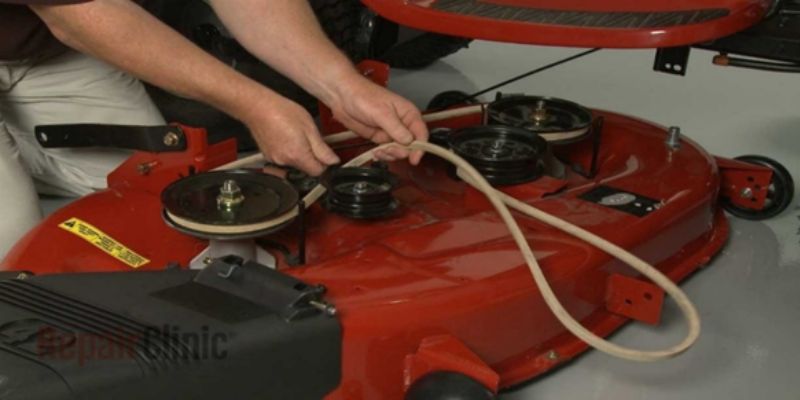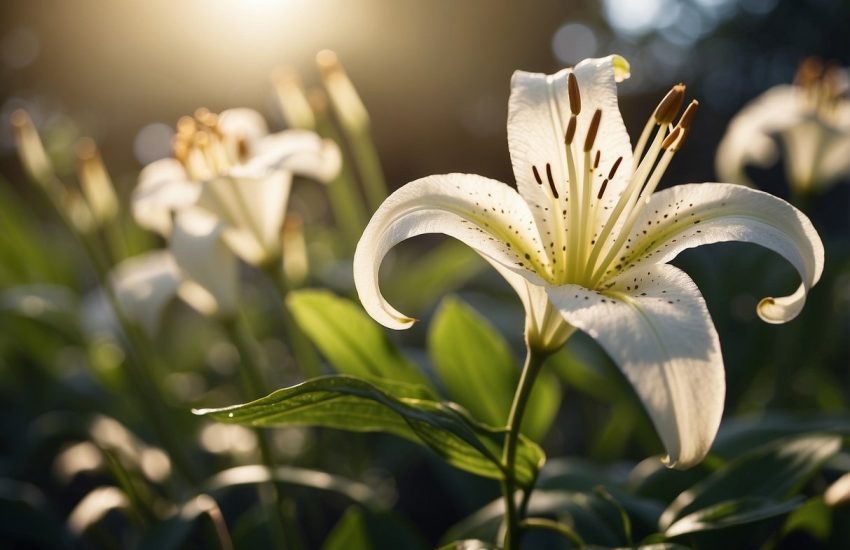Learn About Kentucky Bluegrass – How To Grow And Care
Kentucky bluegrass is one of the most commonly used lawn types in the US. It is a perfect lawn for erosion management, it has a durable profile in drier summer regions. Therefore because of its one-of-a-kind bluish-green color, you can add more beauty to your yard or garden.
It is a simple procedure. You can have the most beautiful and healthy-looking Kentucky bluegrass if you can trace the precise planting, mowing, and fertilization requirements.
Kentucky bluegrass (Poa pratensis) is a cool-season type of turf, meaning it grows best in temperatures between 65 and 75 degrees Fahrenheit and is best suited to the central and northern regions of the United States.
Grassland varieties have slightly different growth and wear characteristics than other common grasses.
Kentucky bluegrass is native to and therefore can be found throughout Europe, Northern Asia, and also the Algerian and Moroccan highlands. Even though the Kentucky state claims the name “Bluegrass State”, it is known that the early colonists brought these seeds along with many different kinds of turf with them to the new lands. So it is safe to say that Kentucky bluegrass is not native to Kentucky. However, the cold and moist weather of this region is perfect for growing this type of lawn.
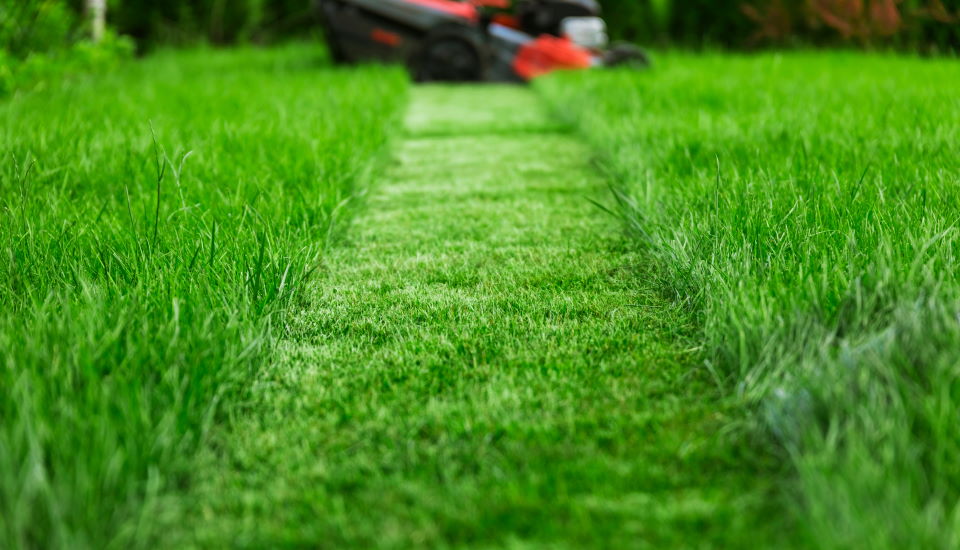
It is a prominent turf type in the US, particularly in the colder northern regions. It takes longer to develop than other cool-weather grasses, but once it does, it is highly hardy.
If you ask this question to turf owners in the US, what is the best kind of grass, you are most likely to hear the answer: the best option is Kentucky bluegrass. The reason behind that estimation is that this grass can produce a thick, succulent, and long-lasting turf that lives up to its name if you give the appropriate growth circumstances. But it is not as easy as you may think. Because of its nature, Kentucky bluegrass requires a lot of your time and attention as it can be considered a high maintenance lawn.
Here is some crucial information about Kentucky Bluegrass
- It is suitable for cold seasons.
- It can endure winter coldness.
- Some of its varieties can endure high temperatures and dryness.
- It can repair itself.
- It doesn’t like shade very much.
The Grass Type
Kentucky bluegrass is a spreading type of turf. It is a perennial type of grass which means it can endure cold climates also grows best in those weathers and grows the following year again.
Since this type of turf is more delicate to dryness, it is no surprise that it can grow better in colder climates. It has shallow roots and therefore cannot reach the dampness within the soil exceptionally well, so it can easily become desiccated.
As mentioned above, Kentucky bluegrass is not very suitable for shaded places. This grass likes to sunbathe as much as it likes cold weather, therefore it likes sun without hot temperatures.
How to Best Grow Kentucky Bluegrass
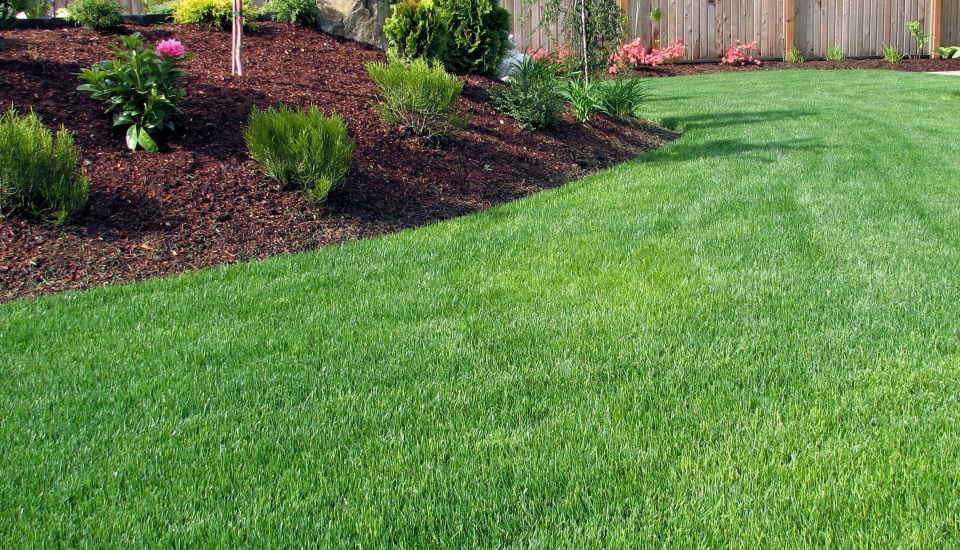
The seeds should be planted in cool weather, which means fall is the perfect time to plant. Also, the cold weather of fall is a convenient time for the grass to grow. The most moderate temperature for Kentucky bluegrass to thrive the quickest, the soil needs to be 10 to 20 degrees(50-65 Fahrenheit). However, spring can also be convenient for planting since this plant belongs to the cool-season grass family.
You may prefer to start the process with sods because its germination is generally longer than other perennial cold weather grasses. By doing that, you can fasten up the process of foundation. By now, we know that Kentucky bluegrass doesn’t like the shade, therefore it is advised to mix up your seed with other seeds that love shade or grow better in shady weather.
Kentucky bluegrass is needed to be watered via a sprinkler or rainfall at least 1 inch of water each week. To compensate for the higher temperatures in warmer states, boost this to a 2-inch level weekly.
Kentucky bluegrass needs to be mowed at least 2 inches (5 cm) high after the planting. Below this height, the seedlings will be damaged, therefore you need to make sure your lawnmower is set at the proper height.
Kentucky bluegrass species can form thatch very quickly, which can suffocate the younger blades. To avoid too much thatch development, it’s best to bag your clippings.
In this sort of turf, fertilization is essential. Fertilize the lawn 3–4 times a year with 3–5 pounds of nitrogen per 1000 square feet. The exact amount will be determined by the soil’s fertility and the ease with which weeds may grow in the region.
What are the advantages and disadvantages of planting Kentucky Bluegrass?
The Advantages
- It can spread quickly after the foundation.
- If it gets damaged, it can rapidly recover itself.
- It is very hardy in cold temperatures.
- It has tender and moist blades.
The Disadvantages
- It takes a long time to germinate.
- It doesn’t grow in shady weather.
- It is drought-susceptible.
What is the rate of growth of Kentucky Bluegrass?
Kentucky bluegrass takes 2–5 weeks to develop completely. Keep it at the height of 5 cm once it has fully distributed across the lawn.
What is the most proper height for mowing Kentucky Bluegrass?
The answer to this question depends on the timeline you plan to mow.

You need to;
Mow the yard to a height of 2.5′′ – 3′′ inches (6 – 7.5 cm) in the spring and fall.
Mow the yard to a height of 3″ – 3.5″ inches (9 cm) in the summer.
Only mow when required, and keep your turf under 8 inches (20 cm) long.
Grass height maintenance is critical for a healthy, and pretty Kentucky bluegrass yard. Grass must be trimmed and fed on a regular basis while adhering to specified guidelines. Lawns that are lush and lovely are not created by chance. They are the result of meticulous, well-planned care.
The importance of the turf height is not only about the prettiness of your lawn. There are some crucial points to it as well. If you mow your grass too short, you may make your yard prone to a possible weed invasion or disease.
The grass’s ability to generate enough food to fulfill its demands is hampered by the lower surface area. Drought, excessive heat, and constant use during this season can all harm the lawn’s health. It may perish if it lacks sufficient reserves or protection.
And on the contrary, if you let your Kentucky bluegrass grow too long, it can create an environment for pests. Leaving the lawn too high produces an atmosphere conducive to disease development. The turf will grow matted, providing the ideal environment for bugs to dwell.
Root structures that protect lawns under stress, drought, or insect issues benefit from the proper height. Most importantly, a healthy lawn results in less effort and worry for the homeowner. With proper maintenance, chemical fertilizers, bug sprays, pest eradication, grass reseeding, emergency restoration, and patch repair are all reduced.
Aesthetically, improperly mowed turf is also unappealing. Long story short, when the lawn is mowed at the proper height for the grass type, it becomes healthier.
How to Prepare Your Soil for Kentucky Bluegrass?
Depending on the effort and time you spend on improving your soil before you sow a Kentucky bluegrass lawn will define how much you can save your time and money in the long run.
You need to rotate the first 6 inches (15 cm) of your existing soil before planting your Kentucky bluegrass seed. This increases the amount of oxygen in the soil and breaks up compacted areas that inhibit water absorption and root growth.
Add some organic matter such as black topsoil, compost, shredded garden waste (leaves, grass clippings, etc.), or a slow-release organic matter fertilizer.
Apply additional soil amendments if your county extension agent recommends it. Your local real estate agent may recommend having your soil tested first. You can follow their advice on how to get your soil tested.
Planting Kentucky Bluegrass
You must reverse engineer your lawn for it to be successful. Your task requires a fall preparation program to ensure rich spring germination when it comes to cool-season grasses like Kentucky bluegrass.
Aerate your lawn and make small holes in the soil to get started. This will make air, water, and nutrients way to reach the bottom. Depending on its growth rate and age, you may need to separate your lawn first.
Don’t be afraid of overseeding. Overseeding is necessary while planting Kentucky bluegrass as a certain percentage of your lawn will reach the end of its life. Use a spreader or a slicer to seed the lawn, even if there are no dry areas. This is also a smart approach to harvesting the weeds organically.
Finally, add the much-needed fertilizer to the mix. You can test your lawn’s unique chemical makeup, therefore you can choose a fertilizer that provides your grass seeds with the nutrients they need in the appropriate amounts.
Initial Planting
Prepare a sturdy, smooth seedbed and purchase high-quality seeds to establish Kentucky bluegrass seeds. Kentucky bluegrass prefers soil that drains efficiently. Use soil additions to strengthen the seedbed if there are any damaged areas. Cover with dirt no deeper than one-fourth to one-half inch after aerating and seeding.
To maintain effective germination in your soil, you need to irrigate up to 16 inches to keep the moisture. Seeds can take between 21 and 28 days to germinate. Water one to two-and-a-half inches weekly after grass blades sprout and begin to develop in the spring.
How to Mow Kentucky Bluegrass
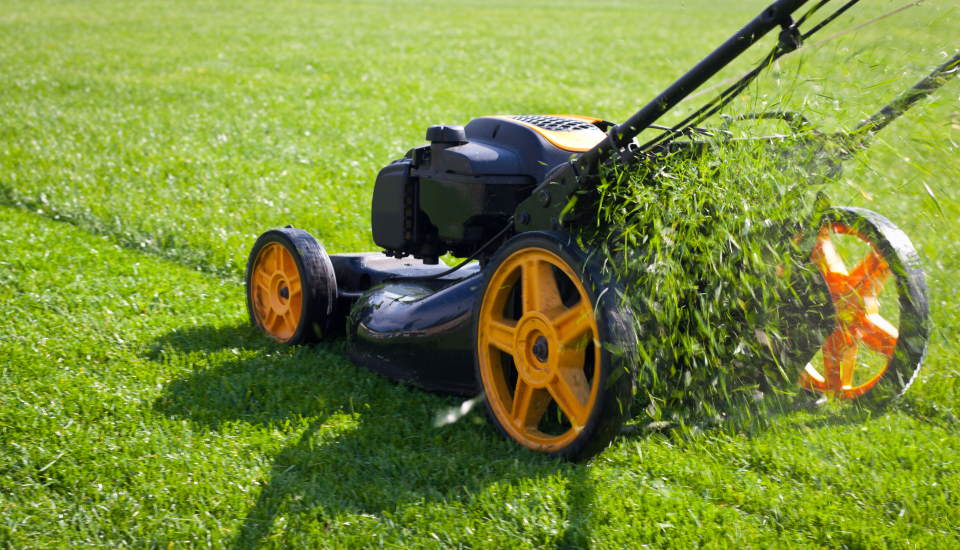
Kentucky bluegrass will thrive with four to six pounds of nitrogen-containing fertilizer per 1,000 square feet during the active growing season. With organic matter such as rotting manure or compost, you can increase soil structure and fertility by eight to ten inches.
It is known that different types of turfs will flourish at different heights. For example, in this case, Kentucky bluegrass is best mowed to a height of 1.5 to 2.5 inches (4-6.5 cm).
Starting with a lower setting and a sharpened blade for your first few mowings is advised. By doing that, you will be allowing sunlight, water, and nutrients to penetrate the base of the lawn. Thus preventing the tips from becoming dull and brown.
Then, every one to two weeks, you need to raise the mower height until it reaches two and a half to three inches. This additional height is going to protect the root system from the harmful rays of the sun. By doing that, you can also help with the maintenance of moisture if you have a scorching or dry summer. This will be very beneficial for Kentucky bluegrass, which may become brown and spotty in dry temperatures.
How to Fertilize Your Kentucky Bluegrass?
In addition to water and sunlight, while planting new Kentucky bluegrass seeds on your lawn don’t forget that those seeds also require soil nutrients. However, not all soil is suitable for growing Kentucky bluegrass seeds, particularly the low-quality soils that frequently surround new plantations. Fertilizing at the proper time of year is essential for supplementing nutrients and ensuring that your turf maintains its optimal health and beauty once it has been established.
The majority of the nutrients your Kentucky bluegrass seed needs are already provided in small, trace amounts to the roots of your grass through natural soil processes. However, Kentucky bluegrass lawns, like any grass lawn, require higher levels of three essential nutrients: nitrogen (N), phosphorus (P), and potassium (K), than are typically found in most soils.
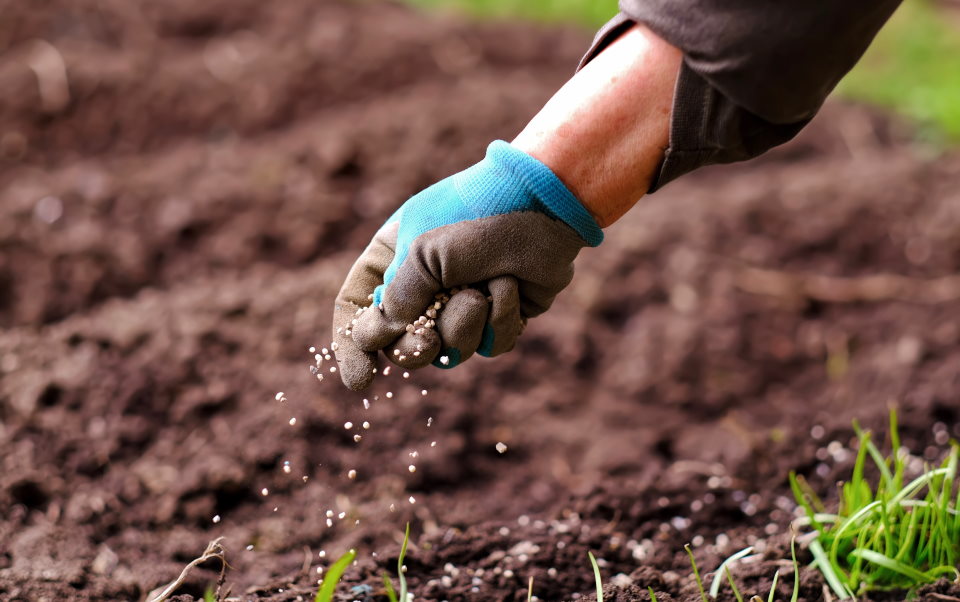
Each commercial fertilizer bag has three numbers reflecting its nitrogen, phosphorus, and potassium content. The specific numbers separated by hyphens represent the percentages of these nutrients in the fertilizer, such as 4-6-4. (or N-P-K). In the case of 4-6-4 fertilizer, the remaining 86 percent consists of filler material (and often additional trace components like calcium, magnesium, iron, and so on) that provides the bulk you need to evenly distribute the fertilizer throughout your garden. The added weight in an organic-based fertilizer is organic matter, which is a critical soil component in sandy and clay soils.
Unfortunately, not most fertilizers are developed to meet the demands of newly planted Kentucky bluegrass seed lawns. Mostly because they require a different combination of nitrogen, phosphorus, and potassium than an already established lawn. When planting your new bluegrass seed lawn, select a “starter” fertilizer or an organic, “slow-release” fertilizer. Use “weed & feed” fertilizers designed for existing lawns instead, as they contain weed-killing chemicals in addition to the fertilizer so that it can’t severely danger or kill your young seedlings.
Kentucky bluegrass prefers full sun and doesn’t like the shade. It can survive through cold winters. But in hot weather, it may fall asleep and turn brown. Also, it gets very susceptible to weed infestation and diseases in hot weather conditions.
Diseases

Kentucky bluegrass also has a prevalent problem that can often occur. The fungus disease shows itself with leaf spots, powdery mildew, and rust. The fungus may be difficult to spot, so it is very important to keep an eye out if you’re planting Kentucky bluegrass. Fungus leaves can usually be dark or white. It is possible to detect damaged grass areas with distinct contours. If you see this problem on your lawn, don’t go out and spray fungicide right away. Wait a few days to observe whether the spot grows larger. If it gets larger you can understand that it is a fungus. If it turns out to be fungus, you can apply a lawn fungicide to the affected area.
Irrigation techniques are also important while planting Kentucky bluegrass. Bad watering practices exacerbate many fungal infections, including fungus leaf spots in the spring and fall when temperatures are between 16 and 26 degrees. You need to irrigate only if it is necessary at this time. Watering during the day can help the water on the grass to freshen and later dry easily.
What is the difference between Kentucky Bluegrass and Regular Grass (Tall Fescue)?
Kentucky bluegrass and tall fescue are the most commonly used cold region types of grass. But what are the differences between them, and what makes Kentucky bluegrass more preferable?
They are pretty different from one another if you look at them generally. First of all, it is easy to see the difference at first glance. Kentucky bluegrass is known for its one-of-a-kind emerald bluish-green color. The smoothness and the velvety feeling it gives under your feet are also one of the reasons why most people would choose Kentucky bluegrass over regular grass. Kentucky bluegrass is a medium-textured dark green grass. Its young leaves are short, have membranous lignified, folded in the bud, and the plant doesn’t have an auricle. Leaf-blades have a boat-shaped tip and parallel blade edges that give them a hard look.
Kentucky bluegrass and Tall Fescue both flourish in the cool season. The fescue may grow to a higher height and is less cold-resistant than Kentucky bluegrass.
We have already mentioned that Kentucky bluegrass takes a longer time to germinate than other grass types. On the other hand, tall fescue can germinate and develop more quickly.
The root structure is important for so many reasons. It aids the turf to have the nutrients it needs from the soil. Tall fescue has a deeper root structure than Kentucky bluegrass. This is one of the reasons why Kentucky bluegrass takes a longer time to germinate.
Kentucky bluegrass grows by rhizomes, forming a hard, dense bark that helps the turf to repair itself if necessary. Therefore results in a dense lawn in your yard. Tall fescue grows in clumps and does not spread like the way Kentucky bluegrass can spread or repair itself in the landscape. This can create a rather unseemly lawn.
Here are some tips on how to care for your Kentucky Bluegrass
- Don’t forget the importance of fertilization with Kentucky bluegrass during the growing season. It is advised to fertilize the turf at least four times at this time.
- It might be hazardous for your lawn to mow when the grass is damp. Never mow when it is damp.
- It is advised only to cut 1/3 of your grass in one cutting. If the Kentucky bluegrass is really tall, then you can mow it a couple of times to get the ideal height.
- Do not mow the lawn frequently, do it as it is needed. It’s typical to mow on a weekly basis, but this ignores the lawn’s unique demands as the seasons change. As the lawn grows quicker in the spring, it will require more frequent trimming. It will most likely need to be mowed twice a week during this stage. Kentucky bluegrass doesn’t grow as rapidly in summer and fall as in the spring, so it doesn’t require that much mowing.
- Leave the cuttings where they are. If the proper mowing schedule is followed, there is no need to collect grass cuttings. Mowing as needed and cutting 1/3 or less each time will result in clippings that disintegrate quickly and easily. Lawn clippings provide soil nutrients such as nitrogen, reducing the demand for chemical fertilizers.
- Be careful with your mower too. Try always to use a sharp mower blade to mow the grass. Instead of cutting, dull blades tug at the grass, pulling it up by the roots. It may result in damaged regions and unattractive, unhealthy patches in your Kentucky bluegrass yard. That’s why blades should be sharpened at least twice a year.
- Do not mow your Kentucky bluegrass in the same directions. Try to change your mowing rotation. Mowing the grass in one direction repeatedly pulls the grass down and hinders a neat cut. Since the mower will consistently follow the same tracks, it might compress the lawn.

